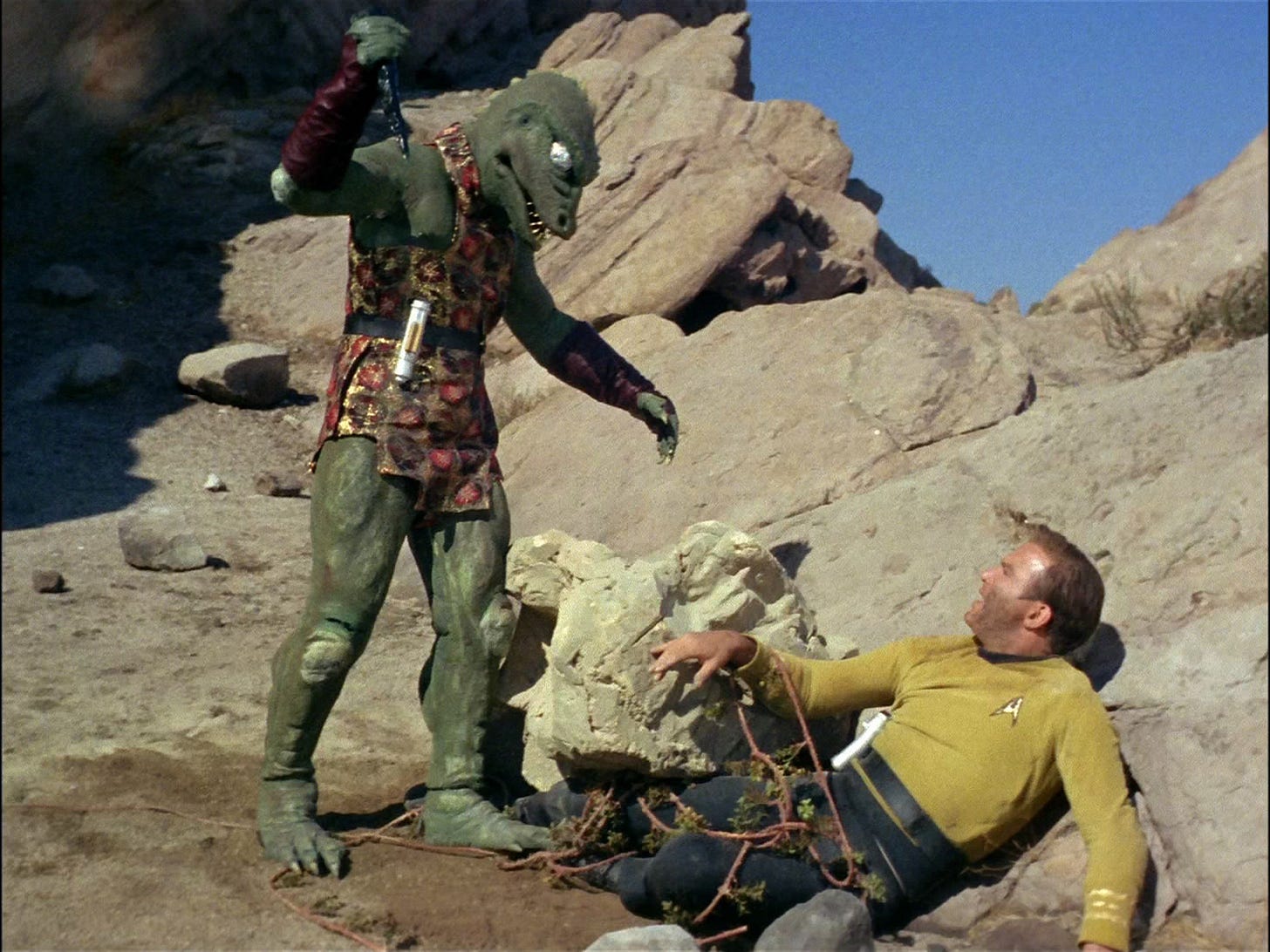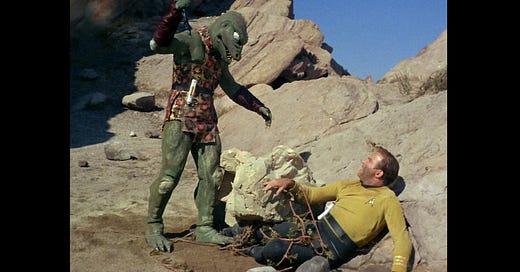If you’ve been compiling a concordance of Red Clay Bestiary you’ll note that while I’m no stranger to the f-word I don’t send legions of them out into the teeth of, uh, your eyes, to be mangled like hapless Russian soldiers bumbling around in the mud of eastern Ukraine. I prefer to drop them one by one, like atom bombs. Usually.
But not always. And this brings us to the fucking Gorn. There’s really no other word that fully captures the sheer, towering, yea fucking prominence of the Gorn in the sea of fifty years of Trek-mania. The Gorn—the fucking Gorn, mind you—is to Star Trek as the stone heads are to Easter Island. I can imagine a time, hundreds of years from now, when all anyone remembers from this show is this ridiculous man-lizard with a fixed rubber jaw and wobbling rubber teeth, and a pair of sparkly silver eyes like Christmas ornaments. The Gorn—a name that sounds as much like a green-faced, ate-a-meatball-off-the-floor, post-meal bolk as anything—moves like a man clenching a two-liter bottle of Pepsi between his buttocks. As exemplars of the violent, dangerous end of the species spectrum, the Gorn is ill-formed. In spite of the involuntary defecation such a creature would predicate if it appeared in your bedroom in the middle of the night, the sprightliness you would gain from such an evacuation would be superfluous in flight. Gorns are fucking slow.
Somehow these pokey iguananoids became one of the most iconic bad guys in the whole series if not the whole franchise.1 The Gorn arrived in “The Arena,” episode 18 in our 79 episode journey, which aired in January of 1967, arguably the last year of the postwar boom; not a year full of good news unless you’re into music, but still a last sliver of relative calm before the Tet Offensive and the assassination of Robert Kennedy and the Chicago Democratic Convention and the presidential election of a true American Gorn: Richard Milhaus Nixon.
Rewinding to the start of the episode we find the Kirk and Spock and Dr. McCoy and a small contingent of plot fodder2 beaming down to some outpost at the invitation of some commander, only to discover that the place has been blown to shit by unknown forces. The gang pokes around for a minute, questioning a dying outposter they find in the rubble, before the attack resumes. Simultaneously an alien spacecraft attacks the Enterprise, conveniently preventing the away team from being beamed right on up. So the gang take up defensive positions as some sort of artillery shells are lobbed at them, making precisely the same whistling sound with every blast. Kirk orders the red shirts to go get killed, which they do with great alacrity and professionalism and at least a little bit of dramatic posing. The survivors make their way, led by a zigzagging, summersaulting Kirk, to a building that’s supposed to be an armory, where he retrieves something that’s supposed to be a grenade launcher. The props in this episode are abysmal.
The grenade launcher—a mortar really—is an obviously plastic tube like something you’d mail a poster in. It’s mounted on a flimsy wire bipod, with which Kirk and Spock wrestle in a game impression of handling something heavy. Kirk opens a box of what are clearly blue plastic Leggs® pantyhose containers. He drops one into the tube; moments later cut to a rotoscoped explosion over the California desert.
The shelling stops. Hey man nice shot.

Kirk and company beam back up and commence pursuit of the alien spacecraft, but, the chase is truncated by a third party—a group of self-righteous superbeings called the Metrons3 who have been watching this whole encounter and decide to broker the disagreement by making the captains of the respective ships duel it out to the death on the surface of another planet (well really the California desert again but with more dramatic rock formations). The crew of the fight’s loser, they are told, will be summarily killed. Somehow this judgement fulfills a condescending sense of justice that only superbeings can appreciate.
At the first sight of the Gorn, the lizard-man with the Fred Flinstone tunic, Kirk pulls a face like he just found half a tapeworm in his breakfast omelette, recoiling in tiny steps calculated to remain in frame while the Gorn labors toward him uncertainly, arms akimbo like Frankenstein monster crossed with a Komodo dragon.
The fight that takes place at this point has to be seen to be believed.
But I’ll try. The most important characteristic is the speed, or lack of same. Kirk could simply stroll away any time he took a liking to. Amble even. Instead he seems to be trapped in amber, staggering backward as ineffectually as the Gorn staggers forward—fisticuffs in a retirement home. The Gorn picks up a big branch and Kirk responds by clambering up to the crotch of a spindly desert tree, probably a foot and a half off the ground—I have no idea why he does this. He then breaks a much smaller branch off the tree. It’s of no more utility than a feather duster, but neither is the Gorn’s branch, which he swings like he’s fanning an Egyptian princess with a palm leaf. The branch shatters weakly on the tree trunk.
The highlight of the fight comes when the Gorn somehow gets his paws on Kirk and starts squeezing him, strongly I guess, though it looks more like a hug. Kirk somehow frees his hands from this saurian turtleneck sweater and brings them down on either side of the Gorn’s head. It looks about as effective as tickling but down goes the Gorn, and Kirk jogs away like he’s practicing his home run trot.
A blow by blow account of the whole fight would add ten thousand words to this post and would only only add a visceral sense of its ponderousness. I’ll leave that to your imagination instead and cut to the coup. Gradually it dawns on Kirk that the planet’s surface is covered in large deposits of very obsequious minerals—sulphur, saltpeter, flint, coal. Diamonds. Yes, diamonds. The only thing missing is a page from The Anarchist’s Cookbook. Kirk silently gathers these ingredients keeping the dimmer among us in the dark as to his intentions, as well as picking a tube out of some sort bamboo-like plant—much too suggestive of the grenade launcher from the first battle to keep us in any kind of suspense. He grinds everything up and mixes it—somehow he knows the exact proportions for making gunpowder. He dumps it in the tube, followed by the diamonds. The Gorn shows up, hobbles toward him like he’s got heel spurs, while Kirk uses the flint to fire the crazy apparatus, filling the Gorn’s chest with diamonds.
And then, as he stands ready to dispatch the Gorn with the pitiful weapon he managed to make out of the planet’s militaristic bounty—a shiny green crystal spike about the size of a kitchen knife, Kirk’s conscience arrives, on cue, and Kirk announces he’s not going to kill the Gorn.
The superbeings are surprised and surmise that humanity may yet have a chance, and so they let both ships, crews, and captains proceed on their various merry ways.
I guess the point of all this is to suggest that whatever war-mongering, genocidal habits humans might have, they’ve got some saving graces—mercy in this case. To which I say we’re all damn lucky it was Kirk and not, say, Kid Rock, who, it’s perfectly clear, would not hesitate to kick someone when they’re down. But then I guess that’s why Kirk is shooting Gorns with homemade diamond guns while Mr. Rock is making a public fool of himself shooting sixers of Bud Light with an assault rifle. I don’t suppose he knows what’s actually in those bullets after all.
Kirk, after all, had to be the better warrior before he could be the better man. And to be the better warrior he could not simply rely on brawn; he went to his real strengths: a comprehensive knowledge of minerals and their application in the manufacture of explosives. Shatner, the Canadian, exemplifies not only the angels of our better nature, but the myth of American can-do-ism at the very cusp of its undoing in the jungles of Vietnam and at the hands of Dick Nixon, looming just off-stage in his lizard outfit, silvery eyes glinting there in the darkness of the future.
“Franchise” is, incidentally a linguistic roadmap to the intersection between processed media and processed food.
No particularly interesting guests in this episode except Eddie Paskey, who looks like a red shirt but is actually back playing a recurring character—one that rarely gets a line or a credit—and Ted Cassidy, best known as Lurch from The Addams Family, but also as Balok in “The Corbomite Manuever,” eight episodes back.
Obvious band name alert.




This is great (as always) but I have to put in a kind word for designer Wah Chang, who made the unconvincing Gorn, sure, but also some of the creepier things that threatened to come out of the screen from the somewhat-earlier The Outer Limits anthology series (my favorite is probably the ghostly alien from the episode "Wolf 359" -- sure, once you know it's a pair of human hands in some kind of confining fabric you won't be able to un-see it, but until then it's mighty effective ... or so I thought).
Also, if I recall correctly the short story source for this, also called "Arena" and by a writer named (or nom-de-plumed, I dunno) Fredric Brown, who isn't exactly someone whose name leaps to mind when you think "Golden Age of science fiction," unless you're, well, me, is pretty good.
Fucking Gorn.😹